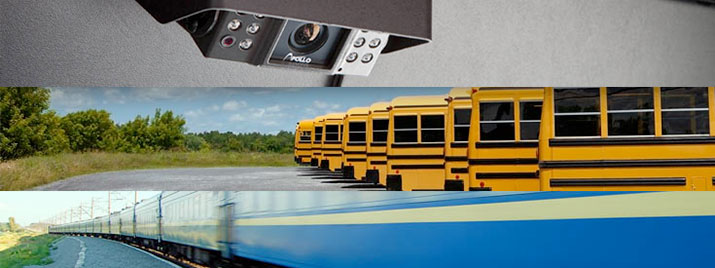
How Transit Video Surveillance Systems Play an Important Role in Security and Efficiency
- By Rodell Notbohm
- Apr 01, 2013

The frequency, severity and sophistication of security breaches and attacks are rising at a considerable rate, as cited in a recent report by Research and Markets. The report specifically mentioned that robbery, theft, shoplifting and terrorist attacks are increasing around the world. Because of this, businesses and governments are increasing their adoption of video surveillance cameras. In fact, many governments have passed stringent regulations to install video surveillance cameras in places such as hospitals, airports, hotels, malls and transit stations.
Protecting Public Ground Transportation
Security for public ground transportation is a major issue around the world, as noted in the report. The 2004 transit bombings in Madrid and 2005 bombings in London are prime examples of the vulnerabilities of transit systems worldwide. These events also brought light to the disparity between transit and airline security spending by the government. According to the American Public Transportation Association (APTA), the government spends .04 cents for every transit trip, compared to nearly $9 per trip for aviation.
APTA estimates a $6.4 billion investment is needed to secure the nation’s transit systems. However, in 2011, the Transit Security Grant Program leveled out at $250 million. This program is critical to preventing terrorist attacks on mass transit systems and is specifically intended to fund efforts to protect transit riders from terrorism, natural disasters and other emergencies. Supporters of the program state that transit security grants show a commitment on the part of the government to protect not only buses, trains, rails and stations, but also the people who use the systems. Without this funding, transit officials argue that they would be forced to close the gap on their own by taking money from their existing operating budgets, likely resulting in reduced service in order to keep the system safe.
Video Surveillance on the Go
Mobile video surveillance systems are being installed in transit agencies across the country. These systems have capabilities beyond standard, off-the-shelf solutions. On bus, rail and paratransit vehicles, light sensitive cameras, digital video recorders and management software programs are being installed to monitor what operators cannot directly observe while driving a bus or operating these vehicles. These video and audio recording systems capture clear video evidence of altercations, injuries, causes of traffic incidents and more.
Grant Money to Improve Transit Security
Major transit agencies across the country are receiving federal grants to improve security by including some of these technology improvements. The Metropolitan Atlanta Rapid Transit Authority (MARTA) in Atlanta received funding for their recent project to install on-board video surveillance systems and vehicle information management software for its fleet of approximately 1,100 transit buses, trains and mobility vans. The on-board system is designed to enhance safety and security for MARTA riders and employees by deterring criminal activity and serving as an investigative tool for the system’s police force. The state-of-the-art installation began in 2012 on MARTA’s buses, and all vehicles are expected to be outfitted by 2014. The system will allow trained MARTA law enforcement staff to monitor live video feeds and respond to incidents on-board and around agency vehicles, stations and transit stops more quickly.
Emphasizing the presence of surveillance equipment to passengers helps promote an agency’s dedication to public safety. Mobile video surveillance vendors are now offering features such as high-resolution display monitors for placement inside a vehicle, viewable by all boarding passengers. Studies have shown that if passengers see themselves on camera, it significantly deters criminal behavior and reduces vandalism to agency property. And, the same equipment, when properly integrated with sophisticated management systems, will notify transit supervisors and law enforcement officials of an on-board incident.
Security Systems Used for More than Safety
Agencies are using these sophisticated systems for employee training and recognition programs, as well as for community relations. In 2005, Asheville Redefines Transit (ART) in Asheville, N.C. installed its first mobile video surveillance solution to improve passenger safety and video management. ART uses the recorded video as a teaching tool for administrative staff and driver training. Video of incidents on-board the fleet is used to teach other operators, introduce new procedures and reinforce protocol. ART also uses the video to recognize positive behavior. When a driver has performed an exceptional act of customer service, ART managers may have access to actual footage to teach other drivers best practices. In addition, ART uses video footage as a community relations tool to leverage the safety precautions the agency takes for the benefit of its customers. When asked, many Asheville citizens expressed relief and took comfort knowing that video cameras were installed on the buses for their safety.
Complete Security Overhauls
Some municipalities are approaching complete overhauls to increase safety and security, rather than just acquiring hardware or adding software. In 2012, Montgomery County, Md. Department of Transit Services completed a major purchase of mobile video surveillance systems to replace older systems that were onboard its fleet of Ride On buses. This replacement process is a welcomed accomplishment by the agency’s transit managers, operators and law enforcement officials. A concerted effort to procure high-quality, reliable, technically-advanced and affordable equipment ensures that transit safety and security is the top priority for its entire fleet of Ride On transit vehicles. The Division of Transit Services shares evidence and access to live video feeds with the local police department as a way to ensure efficient, security coverage in the event of an on-board incident. In addition to using video footage to review incidents and understand a series of events on-board, the cameras installed throughout the agencies’ vehicles are strategically positioned to also capture exterior activity and traffic in and around the bus yard.
Montgomery County is setting a standard for implementing strategic security measures throughout the Ride On fleet, as are agencies in neighboring counties. Many other Washington, D.C.-area agencies also use similar equipment, allowing first responders from surrounding counties to cross county lines or city boundaries and still benefit from the compatibility of a standardized system. Other area agencies using this equipment include: Maryland Department of Transportation, Baltimore; Delmarva Community Services, Cambridge, MD; Alexandria Transit Company/DASH, Alexandria, MD; City of Fredericksburg, Fredericksburg, VA; and Potomac & Rappahannock Transportation Commission, Woodbridge, VA. The video management software being installed by MARTA, ART, Montgomery County and many other agencies allows them to enhance and extend their hardware investments while increasing safety and security by integrating video evidence, wireless networks and equipment health data. Workflow is improved, allowing transit managers to monitor bus activity, automatically download video clips, or request specific portions of video for download on-demand. And, when transit agencies invest in this software, they are able to expand their fleet and use ever-changing technology, without sacrificing compatibility or incurring unnecessary resource investments.
Across the country, agencies are beginning to acknowledge the need for, and reap the benefits of, having reliable mobile video surveillance and DVR equipment on their vehicles. Many agencies are going about mobile security procurement in a tech-savvy way that not only increases safety and security, but improves operations as well.